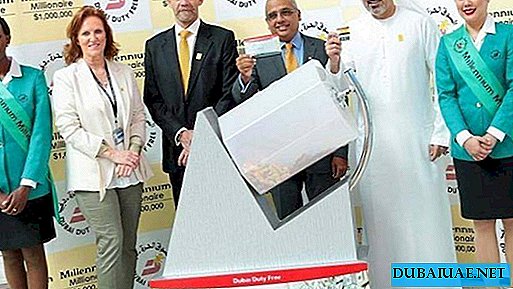 Text and photo: Vladislav Ozerov
Text and photo: Vladislav Ozerov A YEAR BACK WE WELL SUCCESSFULLY DAMAGED ALL THE CORNERS OF THE ARAB EMIRATES AND OMAN, AFTER WHICH WE HAVE AN UNKILLABLE DESIRE TO PERFORM A TRAVEL TO THE LONG COAST OF SANDS AND YOROGA. TO IMPLEMENT THE PLAN, we had to cross the deserts of saudi arabia. OTHERWAY, ABOUT ALL IN ORDER.
Preparation for the trip began with the preparation of the necessary documents: in the Emirates, we paid for two transit visas required for crossing the border with Saudi Arabia (worth 150 dirhams, or US $ 41 each), as well as a Carne de Passage car ticket (800 dirhams , or US $ 219, of which 500 dirhams (US $ 137) can be received back after returning to the country).
According to the plan, they were supposed to leave on August 16. And it happened, however, after a little hesitation in obtaining transit visas to Saudi Arabia caused by a large flow of pilgrims to Mecca (our trip coincided with the holy month of Ramadan). However, in the evening (around 18.00) we still managed to safely leave Dubai and head towards the border with Saudi Arabia (about 500 km), which we approached closer to midnight.
There were no queues at the checkpoint - both on the side of the UAE and on the side of the neighboring state. We were asked to open the trunk and inspected the car for the transport of drugs, alcohol and other prohibited things. After checking, we paid an insurance fee of 70 dirhams (US $ 19) for a period of 7 days.
After crossing the border, we were faced with the question of exchanging currency - Emirate dirhams to Saudi riyals. We turned to the customs officer, who happily reported to us that his brother spoke Russian and would be happy to tell us over the phone about which route is better to follow.
Having listened to all the advice, the customs officer helped us exchange money at the one-to-one exchange rate and pay for applying a protective layer to the car, designed to deal with sandstorms. As it turned out, the protective coating is applied very simply: with a tool such as Fairy, the bumper and front wings of the car are covered - the technology, frankly, is simple.
All conversations and affairs at customs took us about 1.5 hours, after which we moved on. I must say that we crossed the Arabian desert in 18 hours and covered 1800 km. I drove the car all the way myself, because women, as you know, this occupation in Saudi Arabia is imputed to be prohibited. The road that runs along the border with Qatar, Kuwait, Iraq and Bahrain runs through the desert, so we were afraid that a camel might jump out at any time: they say that accidents involving animals are common in this region.
One cannot but note a pleasant moment: the low cost of gasoline for an oil country. As a result, having covered such a great distance, we realized that we spent much more water than fuel, the consumption of which amounted to 80 liters (50 riyals, or US $ 14).
 There were no problems at the border checkpoint with Jordan, but formalities had to be settled again at the entrance: for starters, you had to pay a visa fee (US $ 30), a pass and car insurance for a week (US $ 32). Since here they also accepted only the national currency, namely the Jordanian dinar, I had to constantly run to the exchange office (US $ 1 = 0.7 dinar). I was pleasantly surprised by the appearance on the border of the duty free shop Duty Free, which sells alcohol.
There were no problems at the border checkpoint with Jordan, but formalities had to be settled again at the entrance: for starters, you had to pay a visa fee (US $ 30), a pass and car insurance for a week (US $ 32). Since here they also accepted only the national currency, namely the Jordanian dinar, I had to constantly run to the exchange office (US $ 1 = 0.7 dinar). I was pleasantly surprised by the appearance on the border of the duty free shop Duty Free, which sells alcohol.
On the evening of the second day of our trip, we reached Amman, the capital of Jordan. On our way we met a lot of military bases, but there were just no clusters of civilian vehicles. Drive along the capital's streets, we met a large number of local residents and mountains of garbage, after which we set off to look for a hotel on the coast of the Dead Sea. A day on the road made itself felt, and initially the idea came up to pitch a tent right on the seashore. But with the advent of warning signals about the approach of the Palestinian border and the danger zone, it fell off by itself.
Having slept and bathed in the Dead Sea, the very next morning, we went to Mount Nebo, where, according to legend, the prophet Moses, who rallied the Israeli tribes into a single people, was buried. That is, we, like the famous founder of Judaism, came very close to the promised lands ... However, the upland church, unfortunately, was closed for restoration, and we were not able to visit it.
A little disappointed, we headed to the famous city of Petra, the famous capital of the Nabatean kingdom. By the way, there is a theory according to which the Nabataeans began to populate the modern territory of the United Arab Emirates 4 thousand years ago, so it is quite possible that the modern Emirates are their distant descendants.
Petra, as you know, is not only a stone city, but also a large tourist center, where ours was waiting for a hot dinner and soft bed. To be one of the first tourists in the ancient city, we got up at six in the morning (entrance fee is US $ 75). In three or four hours it is quite possible to see the sights, after which you begin to languish from the heat. The weakest travelers are invited back on camels, donkeys and horses.
After visiting Petra, we headed to Aqaba, which was at one time a Turkish outpost on the Red Sea, conquered in 1971 by Bedouin troops under the command of Lawrence of Arabia. Today this small town attracts a large number of tourists; various hotels of different classes have been built here. If you drive towards the border with Saudi Arabia, you can settle in a tent camp on the beach.
On August 20, on the fifth day of our trip, we set off on a familiar route through the desert of Saudi Arabia. This time it was not possible to get to Egypt: military operations interfered. So it will look for new safe routes and countries. For new discoveries!












